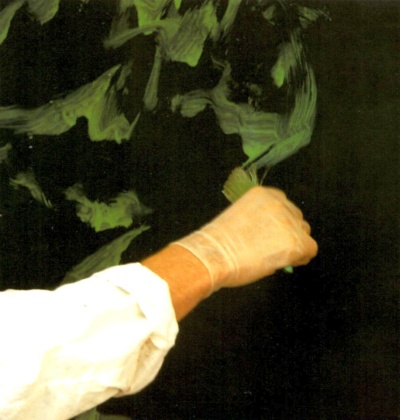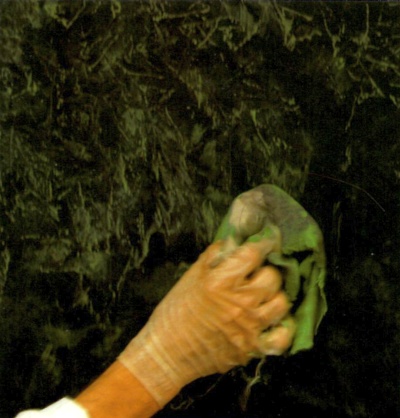Light Over Dark Subtractive Rag Painting Method

Ragged off finish with the colors reversed
When executed in two similar tones (a darker glaze applied over a lighter base), ragging off and cheeseclothing produce a subtle finish.
But when done with the colors reversed - in a dark base coat and light top glaze, the same technique takes on quite a dramatic look.
The final effect of light-over-dark ragging off creates a marble-like surface with great depth, with the light glaze color seemingly floating off the surface. In fact, this finish serves as a background for some advanced marbleizing techniques.
TIP: the rich marble illusion is especially convincing on accessories such as a small table or columns - provided you've chosen a realistic color combination.
But it can also be used on the walls - allover for a striking 3-dimensional effect, or as a faux marble tile treatment if you want to imitate the real thing (you'll need to tape off the "tiles" before painting).
Preparation
Prepare the surface, mix the glaze and gather your tools and materials as described in the basic ragging off tutorial.Also review the simple cheeseclothing technique because this method builds on it.
NOTE: you can get away with using a water-based glaze recipe here only if you have a small surface to rag off. But know that even on small areas, an oil-based glaze will produce a much deeper, more translucent effect.
Besides, this color stacking (light over dark) shows more mistakes than traditional (dark over light) applications, and water-based products won't give you enough time to play with the glaze and correct any mistakes.
Application
1) Over a dark base coat, apply the pale glaze with a side of your brush to a 3'x3' section of the wall.Just like in the 2-color combination ragging and cheeseclothing, you want to paint a random array of wavy strokes, covering about 50% of the base coat.

Vary the strokes - some should be long, some short, some painted on thick, some feathered on, and try to make them all different shapes so that there is no identifiable pattern apparent.
2) Dip your rag into the solvent (water if using a water-based glaze mix, paint thinner or mineral spirits if working with an oil-based glaze recipe). Squeeze it out and blot any drips, then rag off over the glazed surface.

Use pouncing motions but also try dragging the rag on the surface here and there, to blend the glaze into the base color.
3) Take a dry, clean wad of cheesecloth and go over the same area again, to soften the rag imprints and blur the edges. Just be careful not to overdo this step - you don't want to blend away all the definition in the finish.
The combination of textured and clouded areas is what gives depth and realism to this marble imitation.
4) Repeat steps 1-3 on the next section. Unless you taped off the "tiles", blend the adjoining sections into one another, so that you can't tell where the connection was.
Return to Ragging Off Paint Techniques.








